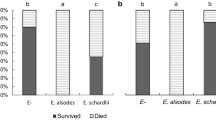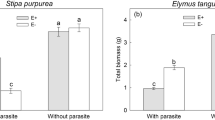Abstract
The three alkaloid groups—lolines, ergopeptides, and peramine— are typically associated with endophyte infection of grasses, with the main function to protect hosts against herbivores. We determined levels of N-formylloline, N-acetylloline, ergovaline, and peramine in 18 European grasses naturally infected with seed-transmitted Neotyphodium endophytes or sexual Epichloë species. Peramine was the most common alkaloid, whereas lolines and ergovaline were only detected in Festuca hosts infected with E. festucae, N. coenophialum, or N. uncinatum. Only ten of the grass species analyzed contained detectable amounts of one or more of these alkaloids. There was a clear tendency for plants associated with stroma-forming Epichloë species to be free of alkaloids, and those that did produce alkaloids contained only small levels of peramine. In contrast, plants infected with seed-transmitted Neotyphodium endophytes often contained extremely high levels of lolines. Lolines enhance host survival through increased protection from herbivores and, thus, may be particularly favored in asexual endophytes that depend on host seed-production for their dispersal.
Similar content being viewed by others
REFERENCES
Agee, C. S., and Hill, N. S. 1994. Ergovaline variability in Acremonium-infected tall fescue due to environment and plant genotype. Crop Sci. 34:221–226.
Arechavaleta, M., Bacon, C. W., Plattner, R. D., Hoveland, C. S., and Radcliffe, D. E. 1992. Accumulation of ergopeptide alkaloids in symbiotic tall fescue grown under deficits of soil water and nitrogen fertilizer. Appl. Environ. Microbiol. 58:857–861.
Bacon, C. W. 1995. Toxic endophyte-infected tall fescue and range grasses: Historic perspectives. J. Anim. Sci. 73:861–870.
Ball, O. J. P., Prestidge, R. A., and Sprosen, J. M. 1995. Interrelationships between Acremonium lolii, Peramine, and Lolitrem B in perennial ryegrass. Appl. Environ. Microbiol. 61:1527–1533.
Ball, O. J. P., Barker, G. M., Prestidge, R. A., and Lauren, D. R. 1997. Distribution and accumulation of the alkaloid peramine in Neotyphodium lolii-infected perennial ryegrass. J. Chem. Ecol. 23:1419–1434.
Belesky, D. P., Robbins, J. D., Stuedemann, J. A., Wilkinson, S. R., and Devine, O. J. 1987. Fungal endophyte infection-loline derivative alkaloid concentration of grazed tall fescue. Agron. J. 79:217–220.
Bultman, T. L., and White, J. F., Jr. 1988. “Pollination” of a fungus by a fly. Oecologia 75:317–319.
Bultman, T. L., White, J. F., Jr., Bowdish, T. I., and Welch, A. M. 1998. A new kind of mutualism between fungi and insects. Mycol. Res. 102:235–238.
Bush, L. P., Fannin, F. F., Siegel, M. R., Dahlman, D. L., and Burton, H. R. 1993. Chemistry, occurrence and biological effects of saturated pyrrolizidine alkaloids associated with endophytegrass interactions. Agric. Ecosyst. Environ. 44:81–102.
Bush, L. P., Wilkinson, H. H., and Schardl, C. L. 1997. Bioprotective alkaloids of grass fungal endophyte symbioses. Plant Physiol. 114:1–7.
Christensen, M. J., Leuchtmann, A., Rowan, D. D., and Tapper, B. A. 1993. Taxonomy of Acremonium endophytes of tall fescue (Festuca arundinacea), meadow fescue (Festuca pratensis), and perennial rye-grass (Lolium perenne). Mycol. Res. 97:1083–1092.
Chung, K.-R., and Schardl, C. L. 1997. Sexual cycle and horizontal transmission of the grass symbiont, Epichloë typhina. Mycol. Res. 101:295–301.
Clay, K. 1988. Fungal endophytes of grasses: A defensive mutualism between plants and fungi. Ecology 69:10–16.
Coley, A. B., Fribourg, H. A., Pelton, M. R., and Gwinn, K. D. 1995. Effects of tall fescue endophyte infestation on relative abundance of small mammals. J. Environ. Qual. 24:472–475.
Daccord, R., Arrigo, Y., Gutzwiller, A., and Schmidt, D. 1995. Les endophytes: Un facteur limitant les performances du ruminant? Rev. Suisse Agric. 27:197–199.
Elbersen, H. W., and West, C. P. 1996. Growth and water relations of field grown tall fescue as influenced by drought and endophyte. Grass Forage Sci. 51:333–342.
Fannin, F. F., Bush, L. P., Siegel, M. R., and Rowan, D. D. 1990. Analysis of peramine in fungal endophyte-infected grasses by reversed-phase thin-layer chromatography. J. Chromatogr. 503:288–292.
Glenn, A. E., Bacon, C. W., Price, R., and Hanlin, R. T. 1996. Molecular phylogeny of Acremonium and its taxonomic implications. Mycologia 88:369–383.
Gwinn, K. D., and Gavin, A. M. 1992. Relationship between endophyte infestation level of tall fescue seed lots and Rhizoctonia zeae seedling disease. Plant Dis. 76:911–914.
Huizing, H. J., Van der Molen, W., Kloek, W., and Den Nijs, A. P. M. 1991. Detection of lolines in endophyte-containing meadow fescue in The Netherlands and the effect of elevated temperature on induction of lolines in endophyte-infected perennial ryegrass. Grass Forage Sci. 46:441–445.
Justus, M., Witte, L., and Hartmann, T. 1997. Levels and tissue distribution of loline alkaloids in endophyte infected Festuca pratensis. Phytochemistry 44:51–57.
Kennedy, C. W., and Bush, L. P. 1983. Effect of environmental and management factors on the accumulation of N-acetyl and N-formyl loline alkaloids in tall fescue. Crop Sci. 23:547–552.
Kimmons, C. A., Gwinn, K. D., and Bernard, E. C. 1990. Nematode reproduction on endophyteinfected and endophyte-free tall fescue. Plant Dis. 74:757–761.
Latch, G. C. M., Hunt, W. F., and Musgrave, D. R. 1985. Endophytic fungi affect growth of perennial ryegrass. N.Z. J. Agric. Res. 28:165–168.
Malinowski, D. P., Belesky, D. P., Hill, N. S., Baligar, V. C., and Fedders, J. M. 1998. Influence of phosphorus on the growth and ergot alkaloid content of Neotyphodium coenophialuminfected tall fescue (Festuca arundinacea Schreb.). Plant Soil 198:53–61.
Miles, C. O., Lane, G. A., DIMENNA, M. E., Garthwaite, I., Piper, E. L., Ball, O. J. P., Latch, G. C. M., Allen, J. M., Hunt, M. B., Bush, L. P., Min, F. K., Fletcher, I., and Harris, P. S. 1996. High levels of ergonovine and lysergic acid amide in toxic Achnatherum inebrians accompany infection by an Acremonium like endophytic fungus. J. Agric. Food Chem. 44:1285–1290.
Petroski, R. J., Yates, S. G., Weisleder, D., and Powell, R. G. 1989. Isolation, semisynthesis, and NMR spectral studies of loline alkaloids. J. Nat. Prod. 52:810–817.
Porter, J. K. 1994. Chemical constituents of grass endophytes, pp. 103–123, in C. W. Bacon, and J. F. White, Jr. (eds.). Biotechnology of Endophytic Fungi of Grasses. CRC Press, Boca Raton, Florida.
Prestidge, R. A. 1993. Causes and control of perennial ryegrass staggers in New Zealand. Agric. Ecosyst. Environ. 44:283–300.
Richardson, M. D., Cabrera, R. I., Murphy, J. A., and Zaurov, D. E. 1999. Nitrogen-form and endophyte-infection effects on growth, nitrogen uptake, and alkaloid content of Chewings fescue turfgrass. J. Plant Nutr. 22:67–79.
Riedell, W. E., Kieckhefer, R. E., Petroski, R. J., and Powell, R. G. 1991. Naturally occurring and synthetic loline alkaloid derivatives: insect feeding behavior modification and toxicity. J. Entomol. Sci. 26:122–129.
Rowan, D. D., and Latch, G. C. M. 1994. Utilization of endophyte-infected perennial ryegrasses for increased insect resistance, pp. 169–183, in C. W. Bacon, and J. F. White, Jr. (eds.). Biotechnology of Endophytic Fungi of Grasses. CRC Press, Boca Raton, Florida.
Roylance, J. T., Hill, N. S., and Agee, C. S. 1994. Ergovaline and peramine production in endophyte-infected tall fescue: Independent regulation and effects of plant and endophyte genotype. J. Chem. Ecol. 20:2171–2183.
Schardl, C. L. 1996. Epichloë species: fungal symbionts of grasses. Annu. Rev. Phytopathol. 34:109–130.
Siegel, M. R., and Bush, L. P. 1996. Defensive chemicals in grass-fungal endophyte associations. Recent Adv. Phytochem. 30:81–119.
Siegel, M. R., Latch, G. C. M., Bush, L. P., Fannin, F. F., Rowan, D. D., Tapper, B. A., Bacon, C. W., and Johnson, M. C. 1990. Fungal endophyte-infected grasses: Alkaloid accumulation and aphid response. J. Chem. Ecol. 16:3301–3315.
Tepaske, M. R., Powell, R. G., and Clement, S. L. 1993. Analysis of selected endophyteinfected grasses for the presence of loline-type and ergot-type alkaloids. J. Agric. Food Chem. 41:2299–2303.
Western, J. H., and Cavett, J. J. 1959. The choke disease of cocksfoot (Dactylis glomerata) caused by Epichloë typhina. Trans. Br. Mycol. Soc. 42:298–307.
White, J. F., Jr., and Bultman, T. L. 1987. Endophyte-host associations in forage grasses. VIII. Heterothallism in Epichloë typhina. Am. J. Bot. 74:1716–1721.
Yates, S. G., Fenster, J. C., and Bartelt, R. J. 1989. Assay of tall fescue seed extracts, fractions, and alkaloids using the large milkweed bug. J. Agric. Food Chem. 37:354–357.
Yates, S. G., Petroski, R. J., and Powell, R. G. 1990. Analysis of loline alkaloids in endophyteinfected tall fescue by capillary gas chromatography. J. Agric. Food Chem. 38:182–185.
Author information
Authors and Affiliations
Rights and permissions
About this article
Cite this article
Leuchtmann, A., Schmidt, D. & Bush, L.P. Different Levels of Protective Alkaloids in Grasses with Stroma-forming and Seed-transmitted Epichloë/Neotyphodium Endophytes. J Chem Ecol 26, 1025–1036 (2000). https://doi.org/10.1023/A:1005489032025
Issue Date:
DOI: https://doi.org/10.1023/A:1005489032025




